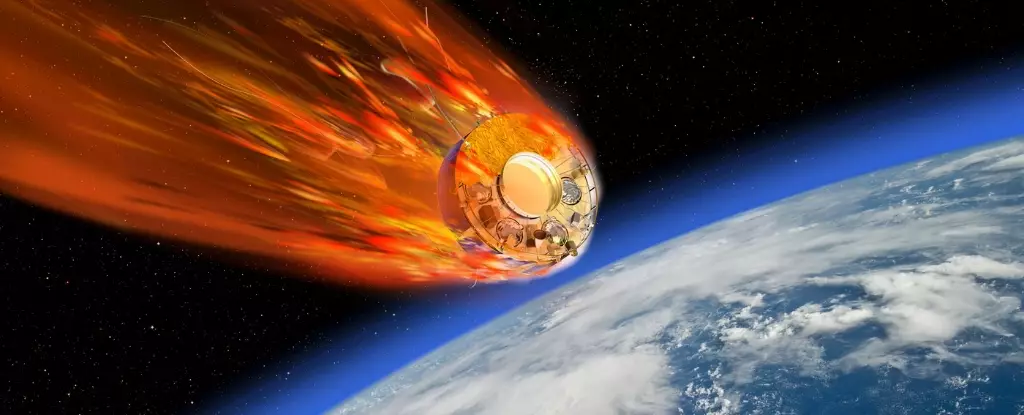The Cold War constituted a turbulent period where geopolitical tensions fueled a race for technological supremacy, manifesting robustly in space exploration. The Soviet Union aggressively pursued the exploration of Venus, a planet often romantically referred to as Earth’s “twin sister.” While their ambitious campaign involved launching 29 spacecraft towards this enigmatic planet between the 1960s and 1980s, the story of one particular spacecraft, Kosmos 482, unfolds as an intriguing chronicle of ambition, failure, and unexpected longevity. This seemingly forgotten relic, heralded as a product of Soviet ingenuity, is scheduled for re-entry to Earth, shedding light on both the achievements and follies of its era.
Kosmos 482 has evaded the fate that befell many of its sibling missions, which succumbed to the demanding conditions of space or were lost in Earth’s atmosphere. Instead, it orbits our planet like a time capsule from the past, reflecting a bold scientific era where victory was measured not just by success, but by the mere act of launching technological marbles into celestial bodies. It serves as a reminder that while the Soviet space program faced numerous obstacles, they also achieved remarkable milestones, including the first successful soft-landing on Venus.
The Quest for Venus: A Double-Edged Sword
In many respects, the Cold War served as a crucible for scientific advancement. Venera 7, launched in 1970, marked a historic moment in the annals of space history by achieving a successful landing on Venus. This scientific feat underscored not only genuine curiosity about the universe but also the political motivations behind it. Missions like these were laden with propaganda, demonstrating the USSR’s technological superiority over the West. The dual objectives of scientific inquiry and political posturing created a complex legacy that taints our appreciation of these missions.
As part of this backdrop, Kosmos 482 was intended to join its more successful counterparts in studying Venusian conditions—conditions so extreme they are often depicted as “hellish.” The thick clouds shrouding Venus ignited hopes of uncovering extraterrestrial life, leading to a fervent belief that other intelligence could exist beyond Earth. However, the mission would unravel dramatically as Kosmos 482 encountered its own turbulence, arising more from bureaucratic miscalculations than from cosmic anomalies.
A Philosophical Reflection on Space Junk
As Kosmos 482 prepares for its uncontrolled descent back to Earth, it reflects the frailty of human ambition amidst the vastness of space. The lander—built to endure crushing atmospheric pressures and incinerating heat on Venus—is now facing an uncertain fate as it heads back into Earth’s atmosphere. With a predicted re-entry expected soon, anxiety surrounds what will happen when it collides with our planet. Will it survive as corroborating evidence of human achievement, or succumb to the very environment it was designed to explore?
Understanding the fate of Kosmos 482 raises sharper questions about the environmental repercussions of our relentless drive for exploration. Concerns about space junk continue to surge as more satellites and spacecraft traverse our skies. The landscape of low Earth orbit has transformed into a form of cosmic debris, with each returning satellite contributing to Earth’s atmospheric pollution. In contrast to the awe of space exploration, the consequences of neglecting our celestial aftermath pose significant challenges for future generations.
Cultural Reflections: The Mythos of Venus
Cinematically, Venus remains entangled in the aesthetics of danger and fear. From the dystopian visions present in films like *The Silent Star* to the horror undertones in *Night of the Living Dead*, the planetary landscape has often been portrayed as hostile, almost malevolent. These representations echo historical anxiety surrounding Cold War tensions, illustrating how the fears of nuclear war were uniquely interwoven with that era’s obsession with space.
As we witness Kosmos 482’s anticipated fall, its arrival might evoke a surreal mixture of nostalgia and dread. Are we ready to reconcile our technological accomplishments with the ramifications they carry? Is the romantic notion of interplanetary exploration overshadowed by the dark specters of war and environmental degradation? The story of Kosmos 482 is more than a tale of a single spacecraft; it’s an emblematic journey showcasing the triumphs and tragedies inherent in humanity’s quest for knowledge.
In this new age of space exploration, it is imperative to adopt an ethical lens as we advance. Kosmos 482 reminds us that every launch into the cosmic unknown comes with a responsibility—a responsibility to preserve the very environment we inhabit, both on Earth and beyond. The struggle between exploration and preservation is not merely a technical hurdle; it’s a profound moral challenge that requires our immediate attention as we forge into an era defined by ever-increasing dependencies on technology and space-based resources.

